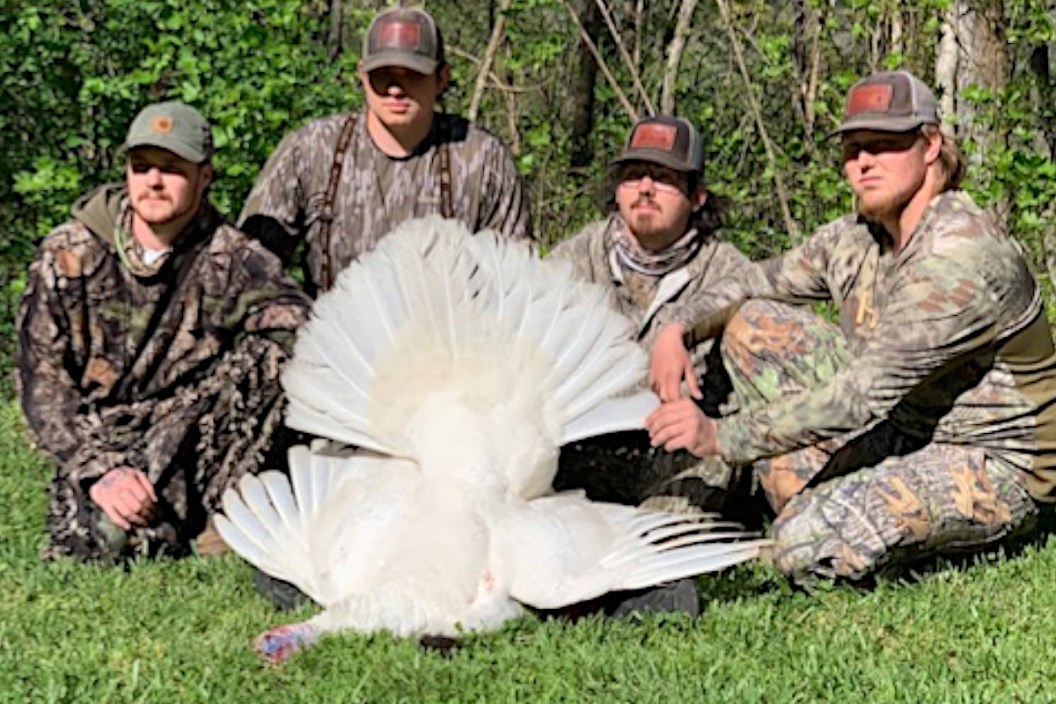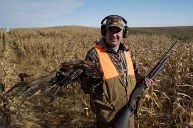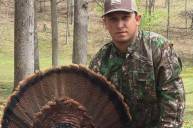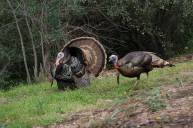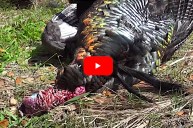A turkey called "The Ghost" was a legend living on public land.
Every hunting area has its own rumors and local legends. You know the kind we are talking about. The kinds that spawn rumors overhead in local coffee shops, and hardware stores, and around campfires on a cold evening. The legends about a monster buck or a huge fish living in the local lake. Many of these stories seem to be centered around animals with a unique color phase.
Which was the case for a unique Tennessee turkey called "The Ghost." The Tom, which was white as snow except for his beard and head, stuck out like a sore thumb, but also somehow managed to elude every hunter in the area for multiple seasons.
That was until 2020 when the bird finally met his match against a group of hunting buddies who worked together to bring the bird down. The hunt was captured on video and became a viral sensation. The backstory behind the taking of this rare bird ended up being just as interesting as the hunt itself. We recently got the chance to talk to the hunters involved and it was one of the best hunting stories we have ever heard.
The Rumors
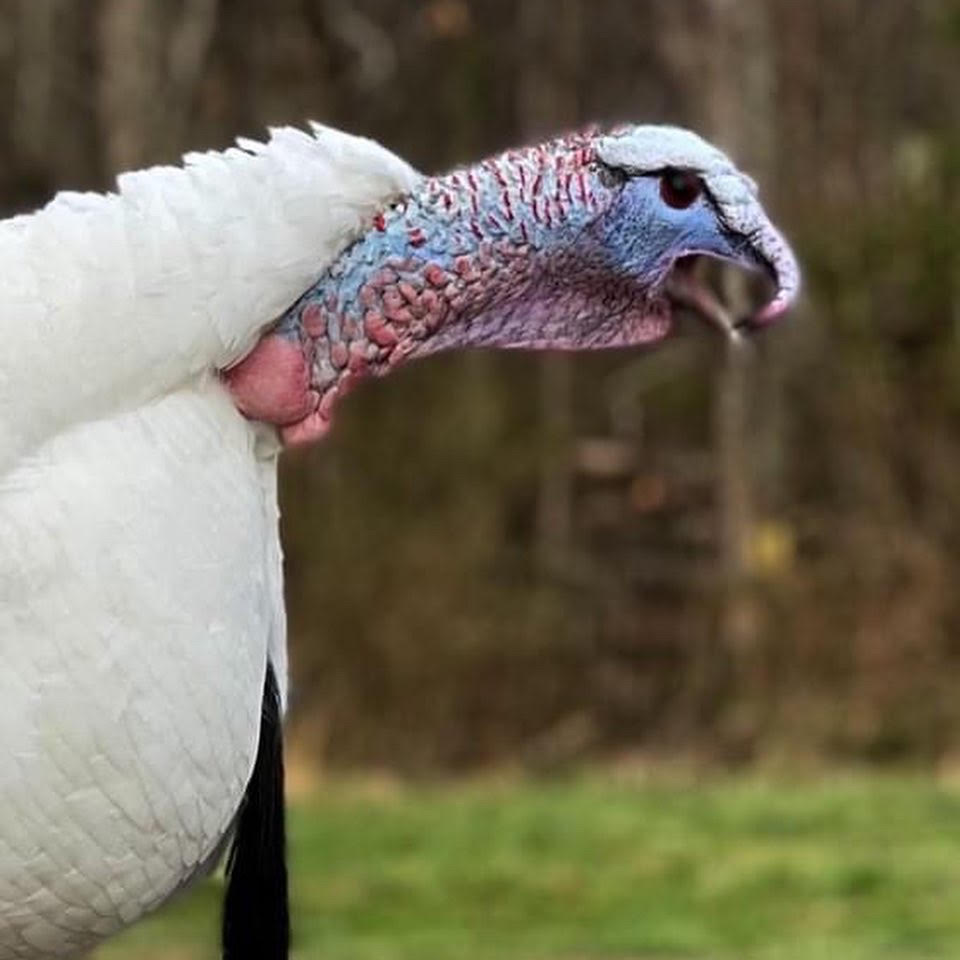
Adam Huckaby
Long before laying their eyes on the ghost on that fateful day of the hunt, Adam Huckaby, Hayden and Hunter Mcintosh and Braxton Smith had heard the rumors of a white gobbler running around their area of East Tennessee. The four friends have been hunting turkeys since they could walk and started up the YouTube channel Running Wild Outdoors together a few years prior. None of them had seen the legendary bird in person until Huckaby and another hunting buddy spotted it while deer hunting. Suddenly, they had a reason to start taking what had previously been only a rumor, much more seriously. Adam recalled how the ghostly turkey was standing on the bank of a lake with around 20 other birds.
"The quest to find him really started back in November during deer season," Huckaby told me in a Zoom call.
Of course, a turkey's location in November is likely to be very different from where he will be hiding in the spring. The area they hunt has major lakes and ridgelines that the birds cross on a regular basis.
"We knew that even though Adam had seen this turkey, we knew there was a chance we may never see him again," Hayden said. "Just because of the fact he could end up anywhere."
There were several other factors that were concerning leading into the hunt. For one, a white bird makes for an easy target for natural predators. Secondly, while the bird was close to public land, there was no guarantee that was where he would be come turkey season.
The Chance Sighting
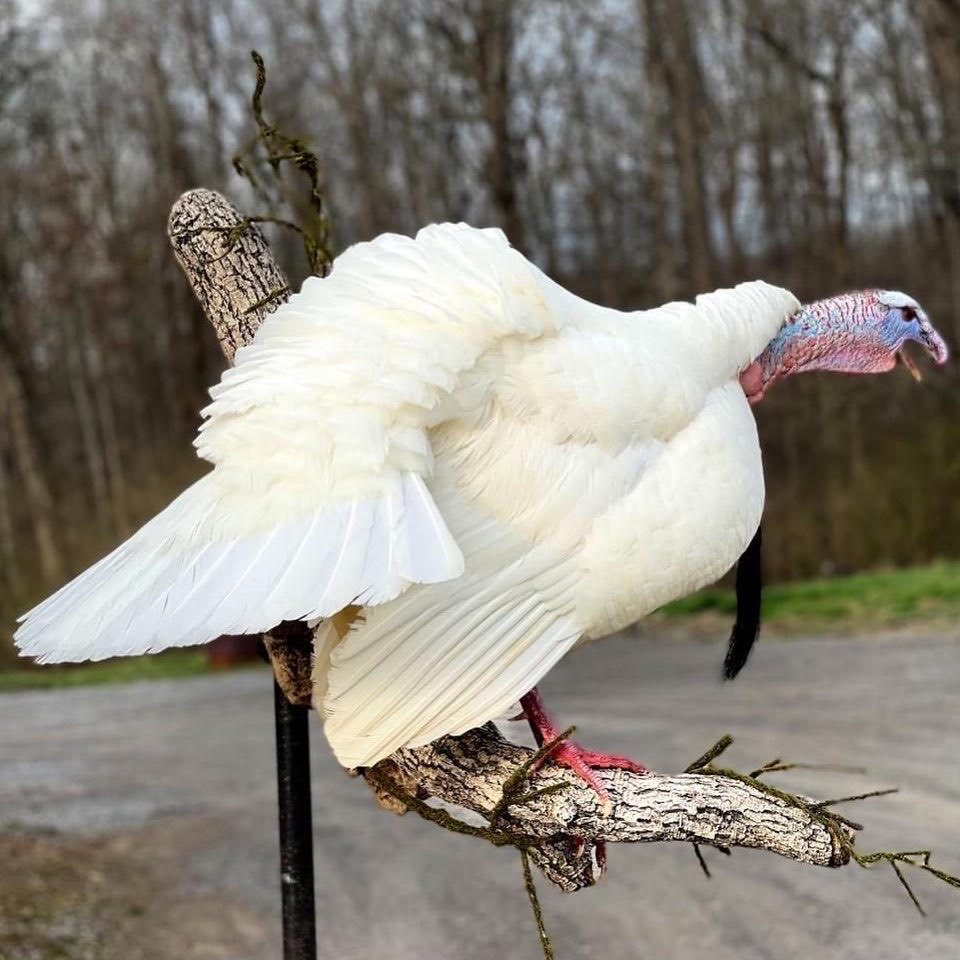
Adam Huckaby
The following spring, the group got a lucky break that clued them into the bird's location during the youth season.
"We got lucky. Our Papaw was fishing, and the turkey actually came across the back of a cove," Huckaby said.
The bird crossed the cove and ran up a ridge. Now they had a general location, and the group immediately began researching OnX Maps and coming up with their game plan. Even then, this turkey was no gimmie. There is an important lesson here in the importance of scouting. Because it was another six days until the regular season opened. In that time, the bird had already moved a mile from where he was last seen. They did not even find a good spot to hunt until the opening day of the season.
"We went around that evening and started driving around the boat and went up and popping up in different fields in this area, glassing and looking for turkey," Hayden said.
While this public area was accessible from land, it is heavily pressured. The group has been hunting this public land for nearly 10 years and they have learned a lot about how the birds behave on it. Most notably, they have noticed that the turkeys seem more responsive to calls that come from an angle from the lake. Hayden suspects it is because the birds have become accustomed to hearing the approaches and calls from hunters coming in from the road.
Fortunately, the hunters managed to catch a glimpse of the ghostly gobbler heading to roost in the evening. The hunters decided to sit on the adjacent field the next morning. They also agreed to keep the calling to a minimum because the bird was especially jumpy. The hunters also did not want to ruin the chance for the other by confusing it with calls coming from two locations at once.
The Hunt
"So, really our game plan was to get on both sides of this field and really try to cover it well," Hayden said. "That way, either way he was to go, somebody would be close enough to get a shot off."
The only thing left to do on their quest was the hardest decision of all. The four friends did not care who shot the bird as long as they captured the whole thing on camera. The only question was who would get to take the shot.
"That night, it came on down to some coin tosses on who was going to be the shooters and who was going to be the camera guys," Hayden said. "Me and Adam flipped a coin, and he won the coin toss."
Little did Adam know just how fortunate the toss was that evening. He noted that he usually does not have that kind of luck.
"First time in my lifetime I've ever won," Huckaby joked.
The next day, the hunters headed to their chosen spot in pitch black darkness to avoid spooking the bird off the place they suspected it roosted overnight. They decided to go with the water approach in worries engine noise from a truck would spook the bird. The two groups of hunters set up about 300 yards apart and waited for dawn to break. They did not have to wait long for the action to start as the woods were soon alive with turkey sounds as the birds came off their roosts. Braxton and Hunter heard the gobbles first, but it took a few minutes before they could see the birds making them.
"A couple hens flew out into the field and then my cousin Braxton he goes: 'Oh crap, there he is, he just flew down, he just flew down into the field," Hunter said.
There was just one problem. The turkey had landed in the least ideal spot in the hunter's field of view.
"Where we are sitting there's a little rise over the hill probably 60 yards that we can't see and that's where he flew, on top of the hill where we couldn't see him," Hunter said. "He was just up there gobbling."
Eventually the two hunters spotted the bird, but he was far out of range. They could only watch as the gobbler began slowly working its way towards Adam and Hayden.
"We were just waiting on the gunshot," Hunter said.
In the video, there is a lot of confusion from Hayden and Adam on where their friends are setup. Hayden notes the group just had a general idea from the OnX Maps where the other was sitting. What Hayden mistakes for their friends sitting on the other end of the field led to some momentary excitement until they realize it was just a series of tree roots.

Adam Huckaby
"We were actually excited for them because we thought at any moment, they were going to get to seal the deal," Hayden said.
Helping add to the drama of the hunt, Adam and Hayden had not expected the gobbler to come over the hill and across the field. This is the most dramatic part of the video as the bird makes his way across slowly but surely. From Adam's angle, he still could not see the bird because of the terrain. His first glimpse of the bird was on the camera's display screen, and it was on that screen that he tracked most of the bird's movements.
"As soon as he (Hayden) said 'there he is,' I can't even explain the burst of adrenaline that was going through my body," Huckaby said.
It may have been a blessing in disguise that Huckaby couldn't see it, and that it took a while before the bird finally walked into an open spot where Adam could see him. As the bird approached, the reality he was going to get a shot at a once-in-a-lifetime bird became a bit overwhelming. He said he was hit with uncontrollable shakes almost immediately.
"It's really a feeling you can't really explain to somebody. The amount of adrenaline that is going through your body at that time," Huckaby said.
Luck was on the hunter's side because another Tom started working its way in from the hunter's side around that time and the Mossy Oak camo did the job keeping them hidden. The sight of a rival seemed to be exactly what was needed to make the rare bird to close the remaining distance.
From there, the rest was history. Despite being nervous, Adam drops the bird setting off an immediate celebration with the hunters in the video. The Ghost is dead at last and the hunters can finally get a good look at him.
The Aftermath
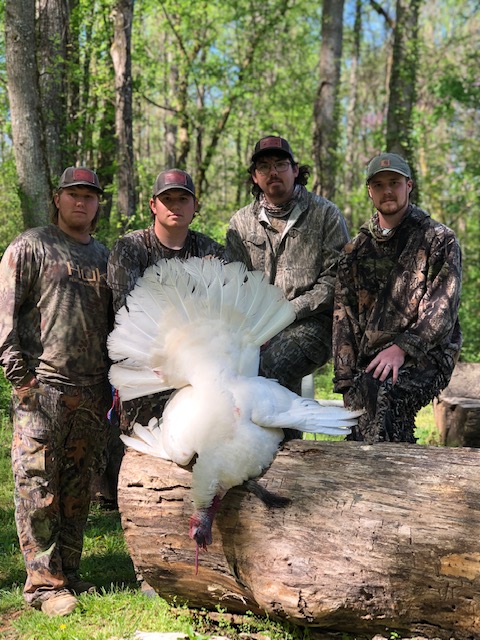
Adam Huckaby
As one would do after such a rare harvest, the hunters immediately took him around to show to all their friends and family.
"Everybody was just as fired up as we were," Huckaby said. "The bird wasn't a secret. Everyone around here who hunts knew about this bird."
Adam said the beard was nearly 11 inches long and the spurs were nearly 1.5 inches. He estimates the Tom was at least four years old when he harvested it. He also notes that the area the bird was harvested also receives heavy hunting pressure. Hearing that brings up all sorts of questions. Mainly, how did it manage to elude hunters and natural predators for so long? The hunters have their theories.
"He was by far, the most on-edge bird I've ever killed," Huckaby said.
Hayden notes that the white turkey just never seemed to relax. He suspects it was slowly conditioned to be much jumpier than normal just because of the nature of its feathers. Even with hens, the bird seemed constantly on edge.
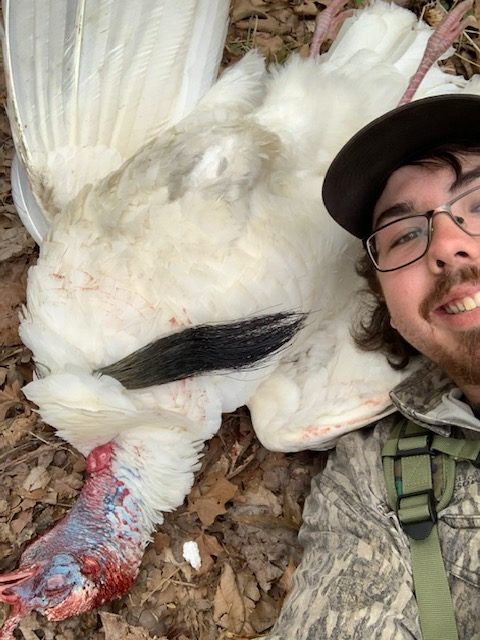
Adam Huckaby
"This bird, he would strut, but he typically wouldn't stay full strutted very long because he wanted to peek his head up and look at his surroundings again," Hayden said. "So, we think this links back to him as a Jake or growing up as a poult. All the predators most likely targeted him first, rather than the others because he stuck out."
It also seems the genes from the bird are in the area. The group has previously seen a white hen, and a friend photographed a white Jake in the area. Smoke phase birds also seem to be common. They are hoping to get an opportunity at one of those birds sometime this season. Huckaby also has some hints as to where he can find some smoke phase birds in another state. Call these guys the "White Turkey Whisperers."
Hayden noted that the video of this bird was what finally gave their YouTube channel a jump. They gained nearly 2,000 subscribers on Running Wild Outdoors immediately following the amazing video of the hunt.
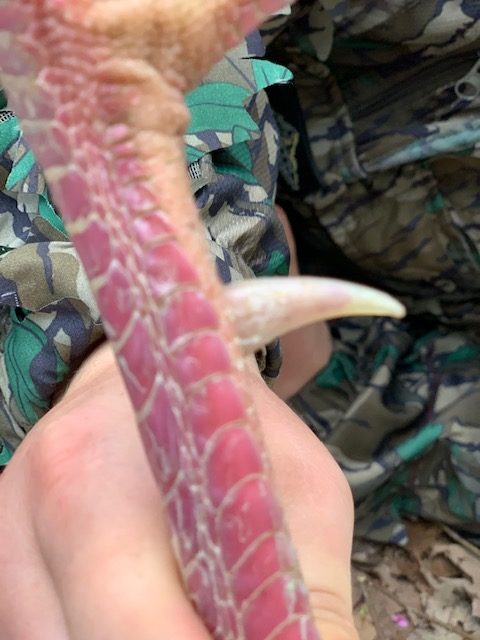
Adam Huckaby
While they call it an albino in the video, they now believe the turkey likely had leucism. The condition is still a lack of pigment, but a lecustic animal often has normal colored features. Adam's turkey has normal eyes and a black beard. The feathers, feet and spurs are much lighter than normal. The animal was not examined by wardens or a turkey expert after the harvest. The group says in hindsight this is their biggest regret. If only so they could learn the bird's age and more about its condition. The hunters did notice a bit of feedback from many people who believed the bird was an escaped domestic animal. The hunters assured me this was not the case. They believe the bird was far too jumpy to be a domestic fowl. Adam said he noticed a distinct difference in the sound of the gobbles between his bird and the kind found in a barnyard too.
Huckaby had the turkey full-body mounted by Wilson's Wildlife Artistry in Crossville, Tennessee. It was really the only way to go with a once-in-a-lifetime bird. Huckaby appears to still have a hard time believing his good fortune.
"To me, that's like shooting a 200-inch whitetail, killing a white turkey, " Huckaby said. "You just don't get an opportunity every day. You don't see one everyday."
For more outdoor content from Travis Smola, be sure to follow him on Twitter and check out his Geocaching and Outdoors with Travis YouTube channels.
NEXT: THE AXIS DEER AND HOW THEY'RE IMPACTING PARTS OF THE UNITED STATES
